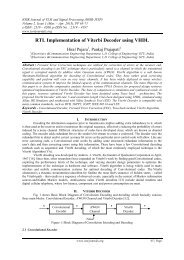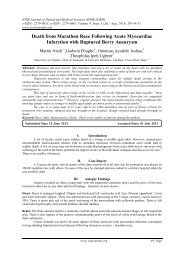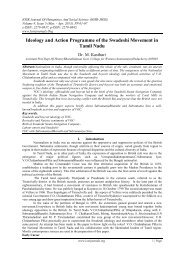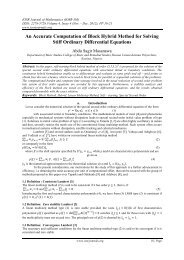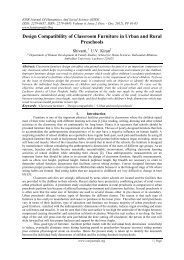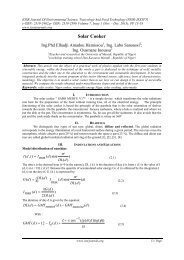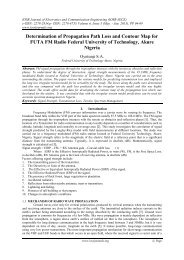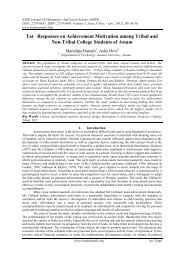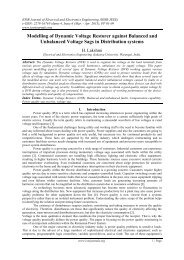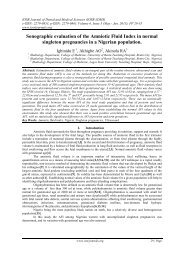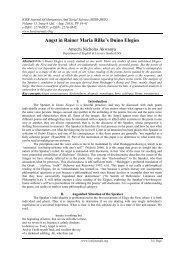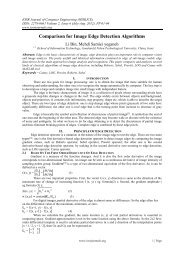Initial Conquest of India by Turks and Their Slaves - IOSR
Initial Conquest of India by Turks and Their Slaves - IOSR
Initial Conquest of India by Turks and Their Slaves - IOSR
Create successful ePaper yourself
Turn your PDF publications into a flip-book with our unique Google optimized e-Paper software.
The Influential Effect Of Folk Arts - Pot Chitra In Present Trend Of Fashion In Bangladesh: An Overview<br />
• Bostani, guthri: A square wrapper for books <strong>and</strong> other valuables<br />
• Dhakni: Covering cloths <strong>of</strong> various shapes <strong>and</strong> sizes<br />
• Daster khan: A spread for eating place, used at meal time<br />
• Balisher chapa or Oshar - A flat single piece pillow cover<br />
• Rumal: H<strong>and</strong>kerchief - Small <strong>and</strong> square in shape<br />
• Ekushey: 21 st <strong>of</strong> February which is calibrate as International Mother Language day<br />
• Taaga: Thin cotton thread used <strong>by</strong> village women, children to hang something with neck, waist, <strong>and</strong> arms<br />
• Panjabis: Bengali traditional costume for men<br />
III. Literature Review<br />
For our research we have choose primary <strong>and</strong> secondary sources to collect the data. We have made<br />
through study books like Banglar Lokoshilpo <strong>by</strong> Dr. P. Ghosh, Proshango: Pot, Potua o Potua Shangeet <strong>by</strong> Dr.<br />
C. Mayti, Gagir Gan: Shilpo Riti <strong>by</strong> A. Ahmed, Potua Roghu Nather Shilpo Bhubon <strong>by</strong> D. Hosson, Openti<br />
Bioscope <strong>by</strong> S. Shom, Bangalir Attoporichoy <strong>by</strong> Mustafa N. Islam, Banglar Lokonattao Palagan: Prokriti o<br />
Proyog <strong>by</strong> Raji. A. Alim, Foklor Shangrohosala <strong>by</strong> Shahed M. Sayed, Shanskritik Oaytijha Abong Nrittoshilpor<br />
Bistar <strong>by</strong> K. Lohani, Banglar Loko Shanskriti <strong>by</strong> W. Ahmed <strong>and</strong> other related books. More information was<br />
gathered from „Openti Bioscope‟ where detailed description is given about Bengali Folk Art like Pot Chitra.<br />
This book was very helpful in providing in depth explanations <strong>and</strong> references <strong>of</strong> other designers who will know<br />
the details information about Pot Chitra.<br />
A. Patua Quamrul Hassan<br />
Quamrul Hassan (1921-1988) occupies the most distinguished place in Bangladesh's fine arts after<br />
master artist Zainul Abedin (1914-1976). His creative talents were multifaceted <strong>and</strong> his art works are<br />
characterized <strong>by</strong> constant reinvention <strong>and</strong> experimentation. His continual experimentation also facilitated a<br />
better underst<strong>and</strong>ing <strong>of</strong> the various media <strong>and</strong> their potential. Besides familiarity, this also gave him a facile<br />
competence in <strong>and</strong> control over diverse forms <strong>and</strong> expressions <strong>of</strong> art. A natural affinity for tradition lies at the<br />
heart <strong>of</strong> Quamrul's aesthetics. He has been eminently successful in blending the folk with the modern, the<br />
indigenous with the western - creating a modern diction that retains its links to indigenous forms <strong>and</strong><br />
expressions sustained over centuries. His works are distinctive because <strong>of</strong> this matchless blending <strong>of</strong> the arts <strong>and</strong><br />
styles <strong>of</strong> the East <strong>and</strong> the West. There has been an additional embellishment at times <strong>by</strong> a measured touch <strong>of</strong><br />
Chinese art, pr<strong>of</strong>ound in the heart <strong>of</strong> his hearts, Quamrul was passionately engaged in the pursuit for beauty all<br />
through his life. This is best celebrated in the portrayal <strong>of</strong> the Bengali women <strong>and</strong> the vitality <strong>of</strong> feminine beauty<br />
in his works. Quamrul Hassan has also been deeply committed to his roots <strong>and</strong> the social responsibility born <strong>of</strong><br />
this sense <strong>of</strong> belongings. He has been closely associated with the progressive inclination in politics.<br />
Nationalism, devotion <strong>and</strong> a tremendous sense <strong>of</strong> the present <strong>and</strong> <strong>of</strong> worldliness were strong in him. He has<br />
never diverged away from the quest <strong>of</strong> humanism <strong>and</strong> the Bengali inheritance. He was against all forms <strong>of</strong><br />
ignorance <strong>and</strong> backwardness <strong>and</strong> was convinced in the progressive values <strong>of</strong> mankind. All through his life, he<br />
has been a free intellectual.<br />
The folk-rootedness in Quamrul was not a exterior thing; it was a heart element <strong>of</strong> his inspirations. His<br />
sense <strong>of</strong> heritage was engraved deeply in his attitude towards life <strong>and</strong> his own philosophy. As a result, elements<br />
<strong>of</strong> myths have greatly prejudiced his works. This would be abundantly clear from a close study <strong>and</strong> analysis <strong>of</strong><br />
his works, the assemble <strong>of</strong> his forms <strong>and</strong> figures, the choice <strong>and</strong> use <strong>of</strong> colours <strong>and</strong> lines as well as the nuances<br />
he weaves into them. A sequential approach would help identify some <strong>of</strong> the sources <strong>of</strong> Qamrul's passion for the<br />
folk.First, it would be recalled that Quamrul Hassan participated in a month long Bratachari camp (December<br />
1939) a year after he got admitted into Kolkata Government Art School (July 1938). Guru Sadoy Dutta's (1882-<br />
1941) Bratachari movement was started with a view to re-establishing the glorious heritage <strong>of</strong> Bengalis as a<br />
rejection <strong>of</strong> <strong>and</strong> expression <strong>of</strong> resistance against British colonial rule. Quamrul Hassan was so influenced <strong>by</strong> the<br />
ideas <strong>of</strong> this movement that he continued to hold on to these ideas until his last days. It was here at the<br />
Bratachari camp that he came across potuas <strong>and</strong> the traditional potua artists <strong>of</strong> Bengal. He learnt about the<br />
significance <strong>of</strong> this age-old art form from Guru Sadoy Dutta. He was attracted <strong>by</strong> the style, especially the use <strong>of</strong><br />
basic colours, methods <strong>of</strong> drawing figures in pr<strong>of</strong>ile, the inherent, two-dimensional features, the unprompted<br />
nature <strong>of</strong> lines etc. Quamrul Hassan used all these features in his own works. He entered a pata painting in the<br />
Muslim Art Exhibition in 1946 for the first time. We find various motifs <strong>and</strong> expressions <strong>of</strong> folk art entering his<br />
world <strong>of</strong> art form <strong>of</strong> dolls, birds <strong>and</strong> fishes from Rajshahi's shakher N<strong>and</strong>i (urn-shaped pot <strong>of</strong> capricious<br />
inclination), the 'evil' owl, fox, snake, crocodile, lizard, or vultures etc. parallel to "beauteous <strong>and</strong> innocent"<br />
animals like peacocks, chicken, cows, horses, elephants, turtles, cats, storks <strong>and</strong> goats. Keeping in mind these<br />
three sources, one may proceed to analyze the nature <strong>and</strong> extent <strong>of</strong> the folk affinity in Quamrul Hassan. It is<br />
clear that he has drawn elements, both <strong>of</strong> style <strong>and</strong> substance, from the folk arts, but his works are not overtly<br />
folk. Quamrul Hassan did not forget even for a moment nor did he allow us to forget that he was a modern artist,<br />
www.iosrjournals.org<br />
36 | Page



